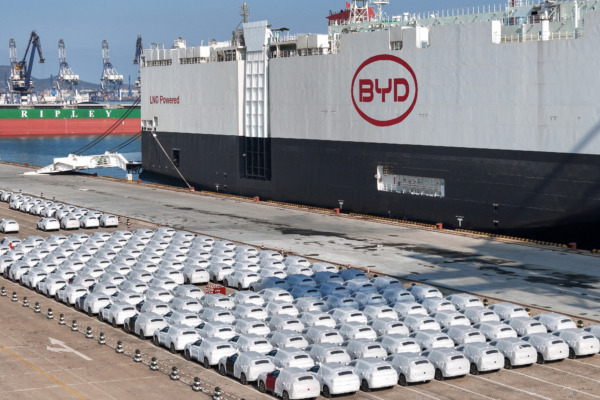BYD has reportedly slowed down production in recent months, reducing shifts at some factories and delaying expansion plans. In May, BYD’s dealer inventory turnover ratio reached 3.21 months, the highest in the industry. Many traditional fuel vehicle manufacturers, new entrants in the automotive industry, and joint venture automakers are facing excess idle production capacity, leading to closures and transformations.
According to Reuters on Wednesday, BYD has canceled night shifts and reduced production by at least one-third in some factories. Due to privacy concerns, the source declined to reveal their identity.
An informed source mentioned that these previously unreported measures have been implemented in at least four factories, with BYD also pausing some new production line construction plans.
Reports also indicated that the specific scale of production cuts and expansion halts has not been determined yet, and it is uncertain how long these measures will last. One source stated that these measures aim to cut costs, while another suggested they were taken after sales fell short of targets.
BYD sold 4.27 million new energy vehicles in 2024, with a revised sales target of 5.5 million vehicles for 2025. However, the cumulative sales from January to May this year were only 1.7634 million vehicles, lagging behind.
Data from the China Association of Automobile Manufacturers shows that BYD’s production growth slowed to 13% in April and 0.2% in May, marking the lowest growth rates since February 2024.
Listed in Hong Kong, BYD’s stock reversed a morning gain of up to 2.6% on Wednesday afternoon, falling by nearly 1%.
A recent survey by the China Automobile Dealers Association revealed that in May, BYD dealers had an average inventory turnover ratio of 3.21 months, the highest among all brands in China, while the industry-wide average was 1.38 months.
Inventory turnover ratio is calculated as end-of-period inventory divided by sales during the same period. This means that even if production stops, BYD would take 3.21 months to clear its inventory.
According to industry standards, an inventory turnover ratio between 0.8 and 1.2 reflects a reasonable inventory level; a ratio above 1.5 signals a cautionary level of inventory, while anything above 2.5 indicates excessive inventory, causing significant operational pressures and risks.
This also explains why BYD initiated two to three rounds of price reductions in 2025. On May 23, BYD announced significant price cuts of up to 34% on 22 models, sparking a new round of price wars that prompted several Chinese automakers to follow suit until the Chinese government intervened.
BYD’s price reduction activities have been ongoing. In early March, the BYD Qin L Intelligent Driving version was priced from 74,800 yuan, breaking industry norms of high premiums for intelligent features.
BYD is not alone in halting expansion. At the “China Automobile Chongqing Forum” on June 7, Geely Auto Chairman Li Shufu mentioned the “severe overcapacity” in China’s auto industry, stating that Geely will refrain from building new car factories or expanding existing production capacities.
Former Vice Minister of the Ministry of Industry and Information Technology, Su Bo, noted that there is an excess of over 30 million units of traditional fuel vehicle production capacity, while most of the over 20 million units of new energy vehicle capacity are newly built, and only 2 to 3 million units of traditional fuel vehicle production capacity have been converted to new energy vehicles.
“Current sales and profit margins of fossil fuel vehicles have significantly declined, and excess production capacity faces a critical situation of life and death. Some companies have already shut down, and the restructuring of the automotive industry is imminent.”
According to the National Bureau of Statistics of China, the capacity utilization rate for the automobile manufacturing industry in 2024 was 72.2%, down by 2.4% year-on-year.
Furthermore, the lagging traditional fuel vehicle production capacity is largely unwanted in the market. For instance, GAC Fick’s Changsha factory held its fifth auction in January 2025, with a starting price significantly lower than the first auction, but all five auctions ended without any bids.
On June 13, 2025, Nezha Auto, the former sales leader in the new energy vehicle market, officially entered bankruptcy restructuring proceedings. Alongside Nezha’s downfall, its three major factories have also halted operations. In fact, other cross-industry carmakers such as NIO, Aiways, Skywell, Baoneng, and Evergrande faced a similar fate of closure and transformation after shutting down.
Several joint venture automakers are also heading towards closure and transformation. In February this year, SAIC-GM closed its Beisheng factory in Shenyang, Liaoning. As one of SAIC-GM’s four major production bases in China, the factory mainly produced Buick GL8, Enclave, and Envision models.
Beijing Hyundai, which originally had five factories in China, now only maintains production at its third factory in Beijing. On June 20, 2023, Hyundai Motor Group CEO Chang Zai-hoon announced the closure of one factory in China and the sale of two others.
In June 2024, Nissan closed its joint venture Changzhou passenger car factory with Dongfeng Motor, marking its first closure of a passenger car factory in China. In July, Honda China announced the closure of some production lines in China. Guangzhou Honda closed its fourth production line with an annual capacity of 50,000 vehicles in October, while Dongfeng Honda shut down its second production line with an annual capacity of 240,000 vehicles in November.

